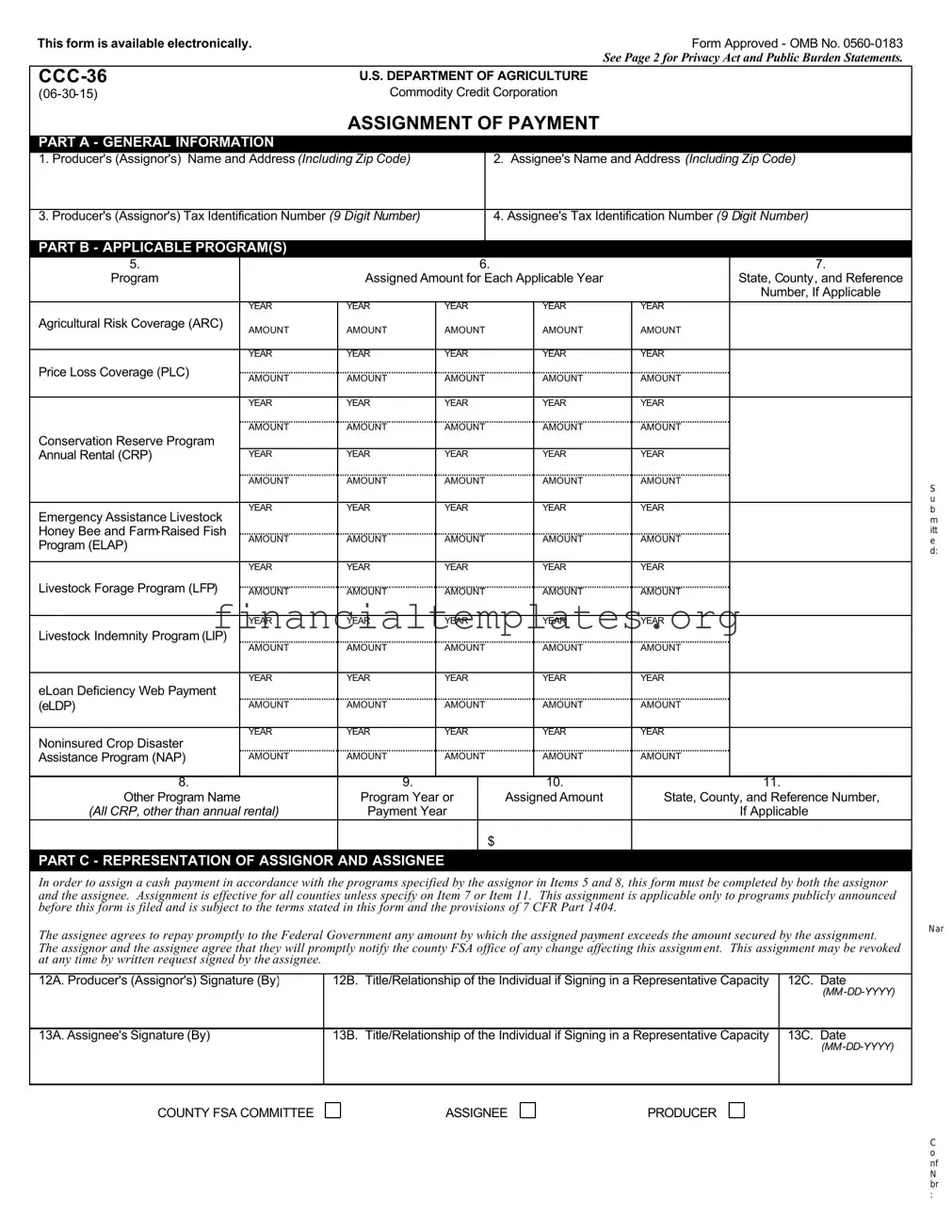|
CCC-36 (06-30-15) |
|
|
|
Page 2 of 2 |
|
PART D - REVOCATION OF ASSIGNMENT |
|
|
|
|
|
|
|
|
|
|
|
Assignment of payment authorization above is hereby revoked. |
|
|
|
14A. Assignee's Signature (By) |
14B. Title/Relationship of the Individual if Signing in a Representative Capacity |
14C. Date |
|
|
|
|
|
(MM-DD-YYYY) |
|
|
|
|
|
|
|
FOR COUNTY OFFICE USE ONLY |
|
|
|
|
|
|
|
|
|
|
|
15. Receiving State and County |
|
16. Date Filed (MM-DD-YYYY) |
17. |
Time Filed |
|
|
|
|
|
|
SPECIAL PROVISIONS RELATING TO ASSIGNMENTS
A.Assignment is effective for all counties unless a specific county is entered in Item 7 or Item 11.
B.If the assignor assigns a specified value of payments to more than one assignee:
1.CCC and FSA will recognize assignments for each program per program year or group of years if multi-year is selected.
2.Assignments will be honored in chronological sequence based on the order of filing with the county FSA office.
C.The payment due the producer may be applied first against indebtedness owing by the producer to the United States, including debts arising after the execution of a Form CCC-36, which may be offset in accordance with the regulations governing, 7 CFR Parts 3, 1403, and 1951, and any balance will be subject to assignment.
D.Neither the United States of America, the Commodity Credit Corporation, the Secretary of Agriculture, any disbursing officer, nor any other Government employee or official shall be subject to any suit or liable for payment of any amount if payment is inadvertently made to the assignor without regard to this assignment.
E.This assignment does not extend to any successor of the assignee, nor may the assignee re-assign this assignment.
F.The assignee’s payment is subject to offset for any delinquent Federal debt owed by the assignee.
18A. COUNTY FSA OFFICE NAME AND ADDRESS (Including Zip Code)
18B. TELEPHONE NO. (Including area code):
NOTE: The following statement is made in accordance with the Privacy Act of 1974 (5 USC 552a – as amended). The authority for requesting the information identified on this form is 7 CFR Part 1404, the Commodity Credit Corporation Charter Act (15 U.S.C. 714 et seq.), and the Agricultural Act of 2014 (Pub. L. 113-79). The information w ill be used to assign payments made under applicable CCC or FSA programs to a designated assignee. The information collected on this form may be disclosed to other Federal, State, Local government agencies, Tribal agencies, and nongovernmental entities that have been authorized access to the information by statute or regulation and/or as described in applicable Routine Uses identified in the System of Records Notice for USDA/FSA-2, Farm Records File (Automated). Providing the requested information is voluntary. However, failure to furnish the requested information will result in a determination of ineligibility to assign applicable CCC or FSA program payments to a designated assignee.
According to the Paperwork Reduction Act of 1995, an agency may not conduct or sponsor, and a person is not required to respond to, a collection of information unless it displays a valid OMB control number. The valid OMB control number for this information collection is 0560-0183. The time required to complete this information collection is estimated to average 10 minutes per response, including the time for reviewing instructions, searching existing data sources, gathering and maintaining the data needed, and completing and reviewing the collection of information. For certain programs such as ARC, PLC, CRP, ELAP, LIP, and eLDP, this information collection is exempted from the Paperwork Reduction Act as specified in the Agricultural Act of 2014 (See Pub. L. 113-79, Title I, Subtitle F, Administration and Title II, Subtitle G, Funding and Administration).RETURN THIS COMPLETED FORM TO YOUR
COUNTY FSA OFFICE.
The U.S. Department of Agriculture (USDA) prohibits discrimination against its customers, employees, and applicants for employment on the basis of race, color, national origin, age, disability, sex, gender identity, religion, reprisal, and where applicable, political beliefs, marital status, familial or parental status, sexual orientation, or all or part of an individual’s income is derived from any public assistance program, or protected genetic information in employment or in any program or activity conducted or funded by the Department. (Not all prohibited basis will apply to all programs and/or employment activities.) Persons with disabilities, who wish to file a program complaint, write to the address below or if you require alternative means of communication for program information (e.g., Braille, large print, audiotape, etc.) please contact USDA’s TARGET Center at (202) 720-2600 (voice and TDD). Individuals who are deaf, hard of hearing, or have speech disabilities and wish to file either an EEO or program complaint, please contact USDA through the Federal Relay Service at (800) 877-8339 or (800) 845-6136 (in Spanish).
If you wish to file a Civil Rights program complaint of discrimination, complete the USDA Program Discrimination Complaint Form, found online at http://www.ascr.usda.gov/complaint_filing_cust.html, or at any USDA office, or call (866) 632-9992 to request the form. You may also write a letter containing all of the information requested in the form. Send your completed complaint form or letter by mail to U.S. Department of Agriculture, Director, Office of Adjudication, 1400 Independence Avenue, S.W., Washington, D.C. 20250-9410, by fax (202) 690-7442 or email at program.intake@usda.gov. USDA is an equal opportunity provider and employer.


